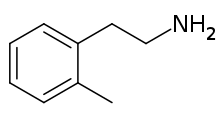2-Methylphenethylamine
2-Methylphenethylamine (2MPEA) is an organic compound with the chemical formula of C9H13N. 2MPEA is a human trace amine associated receptor 1 (TAAR1) agonist,[3] a property which it shares with its monomethylated phenethylamine isomers, such as amphetamine (α-methylphenethylamine), β-methylphenethylamine, and N-methylphenethylamine (a trace amine).[3]
 | |
| Names | |
|---|---|
| Preferred IUPAC name
2-(2-Methylphenyl)ethan-1-amine | |
| Other names
2-(2-Methylphenyl)ethanamine 2-Methylbenzeneethanamine 2-(o-Tolyl)ethan-1-amine | |
| Identifiers | |
3D model (JSmol) |
|
| ChEMBL | |
| ChemSpider | |
| ECHA InfoCard | 100.199.500 |
PubChem CID |
|
CompTox Dashboard (EPA) |
|
| |
| Properties | |
| C9H13N | |
| Molar mass | 135.210 g·mol−1 |
| Appearance | Clear colorless liquid at room temp[1] |
| Density | 0.96 g/cm3[1] |
| Boiling point | 97 °C (207 °F; 370 K) / 5 mmHg (270.7984 °C / 760 mmHg) Experimental[2] |
| Hazards | |
| Main hazards | Corrosive; causes burns |
Except where otherwise noted, data are given for materials in their standard state (at 25 °C [77 °F], 100 kPa). | |
| Infobox references | |
Very little data, even on toxicity, is available about its effects on humans other than that it activates the human TAAR1 receptor.
References
- "2-Methylphenethylamine". Chemical Book. Retrieved 27 May 2014.
- "2-(2-Methylphenyl)ethanamine". Chemspider. Retrieved 27 May 2014.
- Wainscott DB, Little SP, Yin T, Tu Y, Rocco VP, He JX, Nelson DL (January 2007). "Pharmacologic characterization of the cloned human trace amine-associated receptor1 (TAAR1) and evidence for species differences with the rat TAAR1". The Journal of Pharmacology and Experimental Therapeutics. 320 (1): 475–85. doi:10.1124/jpet.106.112532. PMID 17038507.
Several series of substituted phenylethylamines were investigated for activity at the human TAAR1 (Table 2). A surprising finding was the potency of phenylethylamines with substituents at the phenyl C2 position relative to their respective C4-substituted congeners. In each case, except for the hydroxyl substituent, the C2-substituted compound had 8- to 27-fold higher potency than the C4-substituted compound. The C3-substituted compound in each homologous series was typically 2- to 5-fold less potent than the 2-substituted compound, except for the hydroxyl substituent. The most potent of the 2-substituted phenylethylamines was 2-chloro-β-PEA, followed by 2-fluoro-β-PEA, 2-bromo-β-PEA, 2-methoxy-β-PEA, 2-methyl-β-PEA, and then 2-hydroxy-β-PEA.
The effect of β-carbon substitution on the phenylethylamine side chain was also investigated (Table 3). A β-methyl substituent was well tolerated compared with β-PEA. In fact, S-(–)-β-methyl-β-PEA was as potent as β-PEA at human TAAR1. β-Hydroxyl substitution was, however, not tolerated compared with β-PEA. In both cases of β-substitution, enantiomeric selectivity was demonstrated.
In contrast to a methyl substitution on the β-carbon, an α-methyl substitution reduced potency by ∼10-fold for d-amphetamine and 16-fold for l-amphetamine relative to β-PEA (Table 4). N-Methyl substitution was fairly well tolerated; however, N,N-dimethyl substitution was not.
This article is issued from Wikipedia. The text is licensed under Creative Commons - Attribution - Sharealike. Additional terms may apply for the media files.